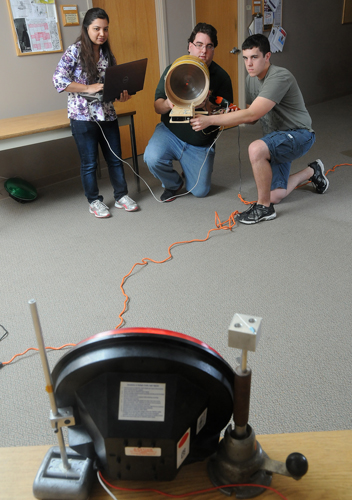
Suzanna Long (far right) with student researchers (l-r) Andrew Clum, Sean Schmidt and Snehal Digraskar. Photos by B.A. Rupert
As Neil Young once said, it’s better to burn out than to fade away. But as many of the nation’s transportation departments have discovered, the light-emitting diodes or LEDs found in most traffic lights don’t burn out — they just lose brightness over time.
Check out the video and story on KY3’s website

Students Snehal Digraskar, Andrew Clum and Sean Schmidt demonstrate an instrument that measures LED intensity.
Knowing when to replace the LED signal heads had become a guessing game, says Suzanna Long, assistant professor of engineering management and systems engineering. So she and other researchers at Missouri S&T, in partnership with the Missouri Department of Transportation, developed an instrument to measure LED intensity. The laser-guided device allows measurements to be taken from the roadside at night, instead of requiring technicians to physically check traffic lights by using a bucket truck.
Long’s team created the measurement tool while working to provide MoDOT with a data-driven replacement schedule for LEDs, which have been widely adopted for use in sustainable traffic signal management.
“The majority of agencies replace LED signals on a spot basis when they receive a complaint,” she says. “The maintenance costs associated with sending a crew out to replace a single LED are very high. Our methodology provides a more cost-effective mechanism for determining replacement and allows agencies to meet goals of being good stewards of public money.”
Long says in addition to addressing individual complaints about brightness, transportation officials have used a generic replacement schedule based on the manufacturers’ warranties, usually six years. But since life expectancy of LEDs varies by intersection and the basic science of LED components, that’s not the most cost-effective schedule.
Working with Long on the project at Missouri S&T are Mariesa Crow, the Fred W. Finley Distinguished Professor of Electrical Engineering; Abhijit Gosavi and Ruwen Qin, assistant professors engineering management and systems engineering; and C.H. Wu, professor of electrical and computer engineering.
Recent Comments